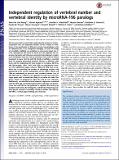Independent regulation of vertebral number and vertebral identity by microRNA-196 paralogs
Author(s)
Wong, Siew Fen Lisa; Agarwal, Vikram; Mansfield, Jennifer H.; Denans, Nicolas; Schwartz, Matthew G.; Prosser, Haydn M.; Tabin, Clifford J.; McGlinn, Edwina; Bartel, David; Pourquie, Olivier; ... Show more Show less
DownloadWong-2015-Independent regulati.pdf (1.618Mb)
PUBLISHER_POLICY
Publisher Policy
Article is made available in accordance with the publisher's policy and may be subject to US copyright law. Please refer to the publisher's site for terms of use.
Terms of use
Metadata
Show full item recordAbstract
The Hox genes play a central role in patterning the embryonic anterior-to-posterior axis. An important function of Hox activity in vertebrates is the specification of different vertebral morphologies, with an additional role in axis elongation emerging. The miR-196 family of microRNAs (miRNAs) are predicted to extensively target Hox 3′ UTRs, although the full extent to which miR-196 regulates Hox expression dynamics and influences mammalian development remains to be elucidated. Here we used an extensive allelic series of mouse knockouts to show that the miR-196 family of miRNAs is essential both for properly patterning vertebral identity at different axial levels and for modulating the total number of vertebrae. All three miR-196 paralogs, 196a1, 196a2, and 196b, act redundantly to pattern the midthoracic region, whereas 196a2 and 196b have an additive role in controlling the number of rib-bearing vertebra and positioning of the sacrum. Independent of this, 196a1, 196a2, and 196b act redundantly to constrain total vertebral number. Loss of miR-196 leads to a collective up-regulation of numerous trunk Hox target genes with a concomitant delay in activation of caudal Hox genes, which are proposed to signal the end of axis extension. Additionally, we identified altered molecular signatures associated with the Wnt, Fgf, and Notch/segmentation pathways and demonstrate that miR-196 has the potential to regulate Wnt activity by multiple mechanisms. By feeding into, and thereby integrating, multiple genetic networks controlling vertebral number and identity, miR-196 is a critical player defining axial formulae.
Date issued
2015-09Department
Massachusetts Institute of Technology. Computational and Systems Biology Program; Massachusetts Institute of Technology. Department of Biology; Whitehead Institute for Biomedical ResearchJournal
Proceedings of the National Academy of Sciences
Publisher
National Academy of Sciences (U.S.)
Citation
Wong, Siew Fen Lisa, Vikram Agarwal, Jennifer H. Mansfield, Nicolas Denans, Matthew G. Schwartz, Haydn M. Prosser, Olivier Pourquié, David P. Bartel, Clifford J. Tabin, and Edwina McGlinn. “Independent Regulation of Vertebral Number and Vertebral Identity by microRNA-196 Paralogs.” Proc Natl Acad Sci USA 112, no. 35 (August 17, 2015): E4884–E4893.
Version: Final published version
ISSN
0027-8424
1091-6490